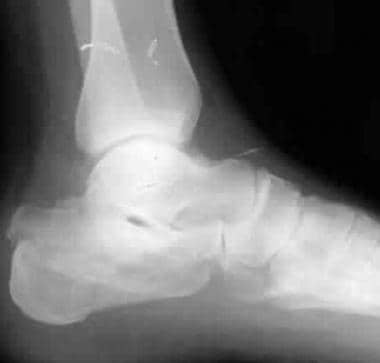

#CALCANEUS FRACTURE ORTHOBULLETS FULL#
There was a trend (p = 0.07) that the longer the interval between the injury and the operation, the longer the subsequent interval until the patient returned to full activities or work. Pain was partially relieved in thirty-eight (90 per cent) of the patients, function improved in thirty-five (83 per cent), and thirty-two (76 per cent) of the patients returned to work or to a pre-injury level of activity at a mean of eight months (range, four to sixteen months) after the operation. The difference between the preoperative and postoperative rating scores was used to measure any improvement in function. The patients were examined at a mean of thirty-two months (range, twenty-six to fifty-two months) after the operation. An in situ subtalar arthrodesis had been performed in fifteen patients a subtalar distraction bone-block arthrodesis, in fourteen a triple arthrodesis, in five a lateral calcaneal ostectomy, in seven a transection and proximal transposition of the sural nerve, in seven and a release of the tibial nerve, in five. The operations had been performed a mean of twenty-six months (range, six to seventy-two months) after the injury. See Instructions for Authors for a complete description of levels of evidence.We retrospectively reviewed the results of the operative treatment of forty-three fractures of the calcaneus in forty-two patients (thirty-six men and six women). An alternative surgical approach may be indicated for the treatment of certain calcaneal fracture patterns with sustentacular displacement.ĭiagnostic Level II. This displacement disproves the "constant" theory of the sustentacular fragment, and it may alter the quality of the fracture reduction and affect patient outcome. This study is the first to our knowledge to quantify in a detailed manner the displacement of the sustentacular fragment as occurring with calcaneal fractures. Three-part or four-part fractures also showed a significant association with overall displacement of the sustentaculum. Fractures involving greater than 50% of the posterior facet (consistent with Sanders Type-B and Type-C fracture lines) demonstrated a significant increase in relative risk of angulation and translation of the sustentacular fragment as well as gapping and intra-articular fractures of the middle facet. Two main fracture types: intra-articular joint depression : articular facet fragment is fractured and separate from the displaced tuberosity. Twenty-five of one hundred calcanei had sustentacular fragment angulation of >10°, twenty-four had sustentacular translation >3 mm, twenty had fracture diastasis of the middle facet, and twenty-one had a displaced intra-articular fracture of the calcaneal middle facet.

Overall, the sustentacular fragment was displaced in forty-two of the 100 fractures. Angulation exceeding 10° and translation of more than 3 mm were considered diagnostic of displacement. Angulation and translation of the sustentacular fragment as well as gapping and intra-articular fractures of the middle facet were examined. CT scans were graded according to the Sanders classification, and associated injuries were noted. Basic patient demographics and mechanisms of injury were recorded. The purpose of this study was to characterize the frequency, magnitude, and mode of displacement of the sustentacular fragment.Ĭomputed tomographic (CT) scans of eighty-eight patients with 100 displaced intra-articular calcaneal fractures admitted to our level-I trauma center over a five-year period were retrospectively reviewed. We hypothesized that the sustentacular fragment in displaced intra-articular calcaneal fractures does not maintain its relationship to the talus. Operative treatment typically occurs through a lateral approach, with the remaining calcaneus being reconstructed back to the sustentaculum. The sustentacular fragment in displaced intra-articular calcaneal fractures has historically been portrayed as a "constant fragment," bound to the talus by the interosseous and deltoid ligament complex.


 0 kommentar(er)
0 kommentar(er)
